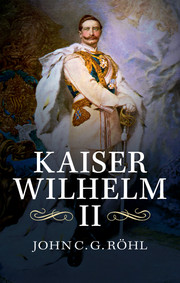Book contents
- Frontmatter
- Dedication
- Contents
- List of figures
- Acknowledgements
- Preface to the English edition
- Preface to the German edition
- Acknowledgements
- Overview: Wilhelm the Last, a German trauma
- Part I 1859–1888: The Tormented Prussian Prince
- Part II 1888–1909: The Anachronistic Autocrat
- Part III 1896–1908: The Egregious Expansionist
- Part IV 1906–1909: The Scandal-Ridden Sovereign
- Part V 1908–1914: The Bellicose Supreme War Lord
- Part VI 1914–1918: The Champion of God’s Germanic Cause
- Part VII 1918–1941: The Vengeful Exile
- 28 A new life in Amerongen and Doorn
- 29 The rabid anti-Semite in exile
- 30 The Kaiser and Hitler
- Notes
- Index
28 - A new life in Amerongen and Doorn
Published online by Cambridge University Press: 05 September 2014
- Frontmatter
- Dedication
- Contents
- List of figures
- Acknowledgements
- Preface to the English edition
- Preface to the German edition
- Acknowledgements
- Overview: Wilhelm the Last, a German trauma
- Part I 1859–1888: The Tormented Prussian Prince
- Part II 1888–1909: The Anachronistic Autocrat
- Part III 1896–1908: The Egregious Expansionist
- Part IV 1906–1909: The Scandal-Ridden Sovereign
- Part V 1908–1914: The Bellicose Supreme War Lord
- Part VI 1914–1918: The Champion of God’s Germanic Cause
- Part VII 1918–1941: The Vengeful Exile
- 28 A new life in Amerongen and Doorn
- 29 The rabid anti-Semite in exile
- 30 The Kaiser and Hitler
- Notes
- Index
Summary
Early in the morning of Sunday 10 November 1918 a spectral little motor convoy appeared at the Belgian–Dutch border crossing at Eijsden. At daybreak the Kaiser had left Supreme Headquarters at Spa in the imperial train. Fearing an attack from his own troops, however, after only a few kilometres he and a small retinue had switched to two automobiles in the hope of reaching the neutral Netherlands unrecognised. In Eijsden Wilhelm II had to wait on the platform, enduring the insults of the angry local populace until the imperial train arrived with the remainder of his entourage and servants. After lengthy negotiations by telephone, Queen Wilhelmina granted the Kaiser asylum in the Netherlands, and Count Godard van Aldenburg-Bentinck agreed to offer him hospitality for three days at Kastell Amerongen, his moated castle in the province of Utrecht. In fact, the uninvited guests – the Kaiserin soon followed – spent the next eighteen months at Amerongen, until in May 1920 Wilhelm was able to move into the nearby property of Huis Doorn with its fifty-nine-hectare park, which he had bought from Baroness van Heemstra for 1.35 million guilders. On 28 November 1918 the Kaiser formally renounced ‘for all time his rights to the Crown of Prussia and thereby to the rights to the German Imperial Crown bound to it’.
Thanks to the generosity of the ‘swinish’ Weimar Republic, as he called it, the Kaiser was able to keep up an enviable lifestyle in exile, in comparison to his hard-pressed former subjects. As early as late November 1918 the revolutionary government in Berlin had approved the transfer of millions of marks to the exiled monarch ‘to maintain a life in accordance with his status’: in the first year of his exile payments to him amounted to no less than 66 million marks. In May 1921 the minister of the Royal House demanded a further 10 million marks from public funds, which was approved. In addition, from the beginning the Kaiser had the contents of his imperial train at his disposal, which included 300 plates and the accompanying silverware. On 1 September 1919 the Prussian finance minister released ‘furniture and other objects designated for the living quarters of the former Kaiser and King’.
- Type
- Chapter
- Information
- Kaiser Wilhelm IIA Concise Life, pp. 181 - 184Publisher: Cambridge University PressPrint publication year: 2014



